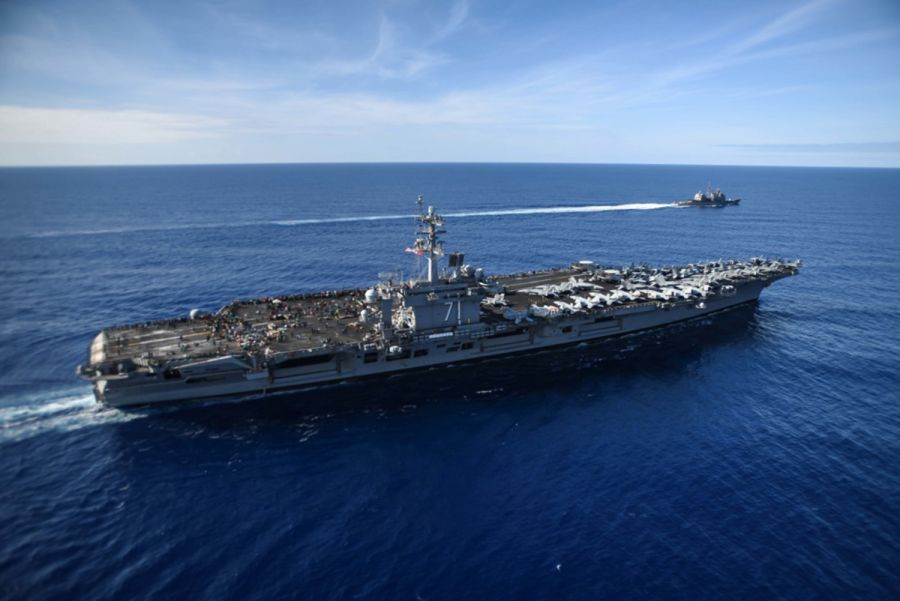

4/3 Update: By the time the sacked captain left his ship on orders from a miffed Pentagon brass because of his leaked letter pleading with the Navy to allow his threatened 5000 crewmembers leave the ship for quarters in hotels in Guam where they could be quarantined and separated to prevent further spread of the coronavirus among themselves fully 1000 of the sailors and pilots on the USS Theodore Roosevelt == 20 percent of the whole crew — had tested positive. My suspicion is that the Navy, hugely unpopular on Guam, didn’t want to anger the locals further by putting COVID-19 infected personnel in local buildings. But the now ex-Capt. Bret E. Crozier, who was cheered by thousands of his crew who view him as a hero, was proven right in saying he needed to get them off the crowded vessel STAT.
4/2 Update: Turns out the captain didn’t send a letter to the SF Chronicle. He wrote a memo and circulated it to some 30 people and one made it to the attention of the Chron. Now the captain has been removed from duty by the Pentagon for blowing the extent of the crisis to the public. The last thing the military wants is for the world to know how completely vulnerable and impractical its $13-billion are. In reality, when it comes to getting taken down by germs like COVID-19 (or the Flu) it turns out that these nuclear flat-tops are just giant cruise ships without all the sex, limitless booze and entertainment.
4/1 Update: According to latest reports, a week after the initial infection of one crewmember on the USS Theodore Roosevelt aircraft carrier, there are now 93 members of the ship’s crew who test positive to the COVID-19 virus suggesting that the navy’s carriers are like petri dishes for spread of an epidemic. The New York Times reports that for two days with the ship docked in Guam, the captain of the vessel has been pleading with the Pentagon to allow his crew to disembark and be separated to prevent further spread. He also complained about a lack of testing equipment to determine who is infected and who is not. “We are not at war,” the desperate and frustrated carrier Capt. Bret E. Crozier finally wrote in a letter published in the San Francisco Chronicle Tuesday. “Sailors do not need to die. If we do not act now, we are failing to properly take care of our most trusted asset — our sailors.” Following bad publicity, the Times reports that the Pentagon will arrange to have the crew removed from the ship to hotel rooms .
Story:
Over the course of just a couple of days last week, the backbone of the US Navy’s Pacific fleet has been shut down for the next month. The enemy that managed to cause this sudden surprise unilateral disarmament of the mighty US Navy’s Pacific Fleet was not Russian or Chinese cyber hackers or a sneak attack by some foreign enemy. Rather, it was just a tiny virus, COVID-19, that infected one crew member on each of two $13-billion Nimitz-class nuclear aircraft carriers.
The USS Reagan and its carrier group of support vessels is now holed up in Japan with at least two infected crew members on board so far and others being quarantined. Meanwhile, the USS Roosevelt, which had been steaming from the its homeport in San Diego armed to the teeth with attack aircraft, bombs other weapons, towards a mission in the South China Sea, has been urgently rerouted to Guam with an onboard epidemic that has already spread to a total of 38 sailors among it’s “Big Stick” crew of 5000.
This effective sidelining of the US Pacific Fleet’s only two carrier groups by some microscopic specks of inanimate RNA protoplasm, offers a perfect metaphor for the absurdity of the decades-long US misallocation of trillions of dollars to the military in the name of national security.
Clearly, the fact that the Navy, deprived of required air cover for the next month, is in no position to engage in significant military action in the Pacific doesn’t put the US in any jeopardy — only the crews of its two carrier groups, who are at risk a spreading coronavirus infection.
Meanwhile, though, the global pandemic caused by that same virus has infected nearly three-quarters of a million people around the globe and close to 150,000 here in America, which has replaced China as the epicenter of the pandemic. The US economy has already been brought to a screeching halt because of a lockdown of the population in most states and urban centers, while hospitals are being overrun with coronavirus patients and their doctors and nurses in desperate need of scarce ventilators, masks, test kits or just empty hospital beds.
Amid this unprecedented crisis, the Pentagon, Energy Department and other military agencies, are seemingly running on autopilot, continuing to spend over a trillion dollars a year (including $13 billion on yet another new carrier, the USS John F. Kennedy, scheduled to be finished and ready for testing later this year), much of it on weapons intended for imagined wars against major powers like Russia and China, or intended for future interventions in countries around the world most Americans cannot even find on a map.
All this spending on arms is happening as it becomes increasingly clear that the biggest threat to the security of the American people is not foreign militaries or terrorist groups, but rather a tiny virus that is completely immune to all the weapons, explosives, cyber defenses, massive surveillance programs, and troops armed to the teeth that the Pentagon can muster.
There is no evidence that either China or Russia, much less any other nation in the world, is remotely likely to attack the US or pose any existential threat to this country, particularly as they are dealing with the pandemic and its economic fallout themselves. Yet financial documents from the Pentagon’s Controller and the Congressional Budget Office show that the US military, which is midway through spending some $300 billion just on weapons acquisition and “modernizing” and upgrading the US nuclear arsenal, plans to spend some $320 billion more this coming fiscal year. Most of the weapons being acquired, like the F-35 stealth fighter-bomber designed to deliver two nuclear bombs in a first-strike on nations with advanced radar (i.e. Russia or China), highly accurate submarine-launched Trident missiles designed for a first-strike on hardened land-based nuclear missile silos, large numbers of new Navy vessels as part of a planned doubling of the total fleet, new intercontinental hypersonic missiles, President Trump’s new Space Force and new smaller “useable” nuclear bomb, frankly have no immediate or probably future use.
Imagine what simply halting those expenditures could do, even if just for the rest of this year and for the coming fiscal year, were the allocated funds to be shifted to domestic use, as the US faces an unprecedented health and economic crisis brought on by this all-too-real attack by COVID-19.
Tens of thousands of respirators, currently produced primarily in China (there is only minimal production capacity in the US), could be purchased and airlifted immediately to the US to address the critical shortage of such life-saving equipment in hospitals across the country. Emergency hospitals, like the one New York State has been creating inside the Javits Convention Center in midtown Manhattan, could be established in similar spaces in cities everywhere as needed. Healthcare coverage could be provided by expanding Medicare or Medicaid to the tens of millions of American workers and their families who are losing their employer-sponsored health insurance along with their jobs because of the lockdowns designed to prevent spread of this virus.
Andrew Bacevich, president of the Quincy Institute for Responsible Statecraft, tells ThisCantBeHappening! he agrees that Congress should reduce funding of the Pentagon and other military agencies like the Energy Department for costly major weapons systems and wars of choice and should shift that money to where it’s needed, which would be combating the current pandemic and redesigning the US healthcare and social system of the US to be better able to confront future crises like this one.
“The United States military is preparing itself for war as we understood in the 1950s, which was war as it was in the 1940s with the addition of nuclear weaons,” this historian, West Point graduate and retired US Army colonel says. “Since then, we have experienced a lot of wars. A couple resembled the Pentagon’s preferred model of war, and here I’m thinking of Operation Desert Storm in 1990-91 and the early stages of the Iraq War in 2003. But the majority of those wars have not conformed to that model. Nonetheless the Pentagon clings to that model of war and to a conception of national security that in no way conforms with actual national security challenges or with protecting the safety of the American people.”
He adds, “The ongoing pandemic unquestionably drives that point home.”
Bacevich is right. The military with its longstanding virtually unchallenged first claim in Congress on US government revenues, is irrelevant to the issues that challenge Americans’ security. We could start to rectify that by taking away the money for the Pentagon’s projects, and handing it over to the civilian heroes who are struggling to combat this tiny but deadly virus, at least for this year. When the pandemic is over maybe the public and the Congress will start seriously considering, in light of the experience, conducting a serious re-evaluation of US spending priorities when it comes to the military budget.
Meanwhile, once the USS Theodore Roosevelt’s and USS Ronald Reagan’s crews are all tested, diagnosed, quarantined and cared for as needed and the ships are thoroughly disinfected, it might be a good idea to cancel their missions on the far side of the globe and send them home. The carrier groups’ thousands of sailors and pilots could surely be more useful helping the country battle the pandemic here.
As US health system critic Wendell Potter comments, “If ever there was a time to divert the spending of hundreds of billions of dollars from the military industrial complex’s imaginary future threats to an all-too-real and potentially devastating current threat to our country and its people it is now.”
